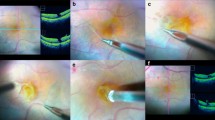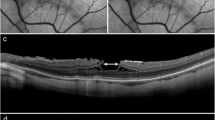Abstract
Purpose
To study the natural course of lamellar macular hole (LMH) as examined by optical coherence tomography (OCT) in a noncomparative observational case series.
Methods
Forty-one eyes of 41 patients with LMH were included in this analysis. Baseline and final OCT findings related to LMH diameter, foveal thickness and visual acuity (VA) were collected and compared. Mean follow-up was 37.1 months. Main outcome measures were best-corrected visual acuity (BCVA), diameter of the LMH opening, foveal thickness, epiretinal membrane (ERM), posterior vitreous detachment (PVD) and vitreoretinal traction.
Results
The diameter of the LMH increased by an average of 13.7%. A statistically significant association was found between the LMH diameter increase and the presence of ERM. The mean foveal thickness depicted a statistically significant decrease between the initial and the final examination. The decrease of the foveal thickness showed to correlate with visual acuity deterioration. BCVA was stable in 30 (78%) and deteriorated in 11 (22%) cases. In eight of the 11 cases, the visual acuity deterioration ranged from 2 to 15 letters.
Conclusion
We identified an increase of LMH diameter related to the presence of ERM and a decrease of the foveal thickness within a period of observation which ranged from 24 to 54 months (mean 37.1 months).






Similar content being viewed by others
References
Gaudric A, Haouchine B, Massin P, Paques M, Blain P, Erginay A (1999) Macular hole formation: new data provided by optical coherence tomography. Arch Ophthalmol 117:744–751
Takahashi H, Kishi S (2000) Tomographic features of a lamellar macular hole formation and a lamellar hole that progressed to a full-thickness macular hole. Am J Ophthalmol 130:677–679, doi:10.1016/S0002-9394(00)00626-7
Haouchine B, Massin P, Gaudric A (2001) Foveal pseudocyst as the first step in macular hole formation: a prospective study by optical coherence tomography. Ophthalmology 108:15–22, doi:10.1016/S0161-6420(00)00519-4
Gass JD (1976) Lamellar macular hole: a complication of cystoid macular edema after cataract extraction. Arch Ophthalmol 94:793–800
Tanner V, Chauhan DS, Jackson TL, Williamson TH (2001) Optical coherence tomography of the vitreoretinal interface in macular hole formation. Br J Ophthalmol 85:1092–1097, doi:10.1136/bjo.85.9.1092
Uchino E, Uemura A, Ohba N (2001) Initial stages of posterior vitreous detachment in healthy eyes of older persons evaluated by optical coherence tomography. Arch Ophthalmol 119:1475–1479
Haouchine B, Massin P, Tadayoni R, Erginay A, Gaudric A (2004) Diagnosis of macular pseudoholes and lamellar macular holes by optical coherence tomography. Am J Ophthalmol 138:732–739, doi:10.1016/j.ajo.2004.06.088
Ko TH, Fujimoto JG, Duker JS, Paunescu LA, Drexler W, Baumal CR et al (2004) Comparison of ultrahigh- and standard-resolution optical coherence tomography for imaging macular hole pathology and repair. Ophthalmology 111:2033–2043, doi:10.1016/j.ophtha.2004.05.021
Witkin AJ, Ko TH, Fujimoto JG, Schuman JS, Baumal CR, Rogers AH et al (2006) Redefining lamellar holes and the vitreomacular interface: an ultrahigh-resolution optical coherence tomography study. Ophthalmology 113:388–397, doi:10.1016/j.ophtha.2005.10.047
Garretson BR, Pollack JS, Ruby AJ, Drenser KA, Williams GA, Sarrafizadeh R (2008) Vitrectomy for a symptomatic lamellar macular hole. Ophthalmology 115:884–886 [Epub 11 Dec 2007]
Wilkins JR, Puliafito CA, Hee MR, Duker JS, Reichel E, Coker JG et al (1996) Characterization of epiretinal membranes using optical coherence tomography. Ophthalmology 103:2142–2151
Allen AW Jr, Gass JD (1976) Contraction of a perifoveal epiretinal membrane simulating a macular hole. Am J Ophthalmol 82:684–691
Massin P, Vicaut E, Haouchine B et al (2001) Reproducibility of retinal mapping using optical coherence tomography. Arch Ophthalmol 119:1135–1142
Polito A, Del Borrello M, Isola M et al (2005) Repeatability and reproducibility of fast macular thickness mapping with stratus optical coherence tomography. Arch Ophthalmol 123:1330–1337, doi:10.1001/archopht.123.10.1330
Margherio RR, Margherio AR, Williams GA, Chow DR, Banach MJ (2000) Effect of perifoveal tissue dissection in the management of acute idiopathic full-thickness macular holes. Arch Ophthalmol 118:495–498
Yooh HS, Brooks HL Jr, Capone A Jr, L’Hernault NL, Grossniklaus HE (1996) Ultrastructural features of tissue removed during idiopathic macular hole surgery. Am J Ophthalmol 122:67–75
Mester V, Kuhn F (2000) Internal limiting membrane removal in the management of full-thickness macular holes. Am J Ophthalmol 129:769–777, doi:10.1016/S0002-9394(00)00358-5
Blain P, Paques M, Massin P, Erginay A, Spielmann AC, Santiago PY et al (1998) Epiretinal membranes surrounding idiopathic macular holes. Retina 18:316–321
Hikichi T, Akiba J, Trempe CL (1993) Effect of the vitreous on the prognosis of full-thickness idiopathic macular hole. Am J Ophthalmol 116:273–278
Ullrich S, Haritoglou C, Gass C, Schaumberger M, Ulbig MW, Kampik A (2002) Macular hole size as a prognostic factor in macular hole surgery. Br J Ophthalmol 86:390–393, doi:10.1136/bjo.86.4.390
Hirakawa M, Uemura A, Nakano T, Sakamoto T (2005) Pars plana vitrectomy with gas tamponade for lamellar macular holes. Am J Ophthalmol 140:1154–1155, doi:10.1016/j.ajo.2005.07.022
Kokame GT, Tokuhara KG (2007) Surgical management of inner lamellar macular hole. Ophthalmic Surg Lasers Imaging 38:61–63
Author information
Authors and Affiliations
Corresponding author
Additional information
The study is not related with any proprietary or commercial interests. No sponsoring organizations have been involved and no grants were received from any organization or institution.
Rights and permissions
About this article
Cite this article
Theodossiadis, P.G., Grigoropoulos, V.G., Emfietzoglou, I. et al. Evolution of lamellar macular hole studied by optical coherence tomography. Graefes Arch Clin Exp Ophthalmol 247, 13–20 (2009). https://doi.org/10.1007/s00417-008-0927-z
Received:
Revised:
Accepted:
Published:
Issue Date:
DOI: https://doi.org/10.1007/s00417-008-0927-z




